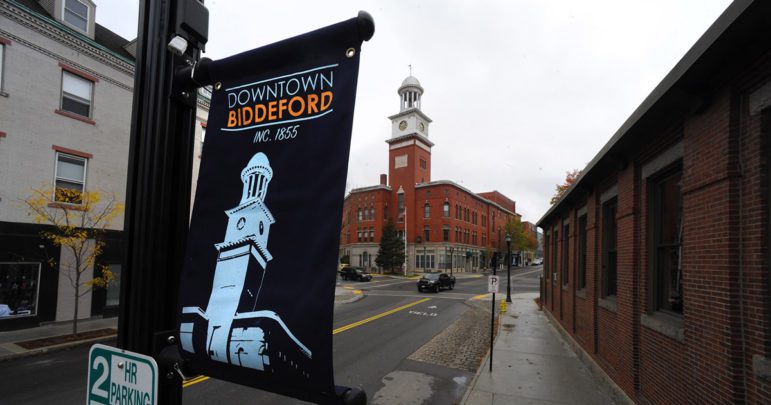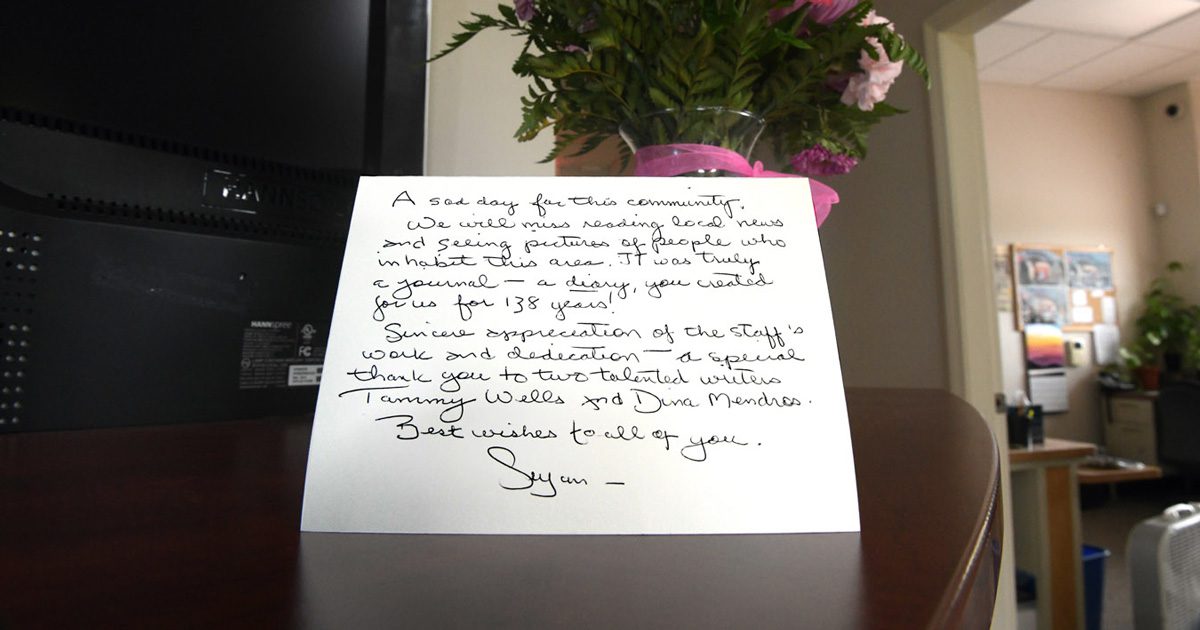Ed Pierce wiped his eyes. It was the gesture of a man who had invested much of the last few years of his career trying to save a small-town newspaper. His shield of affability had failed him, allowing a sadness to escape.
Pierce was the last executive editor of the Biddeford Journal Tribune. The last edition of the five-days-a-week newspaper that had served Biddeford and Saco and Sanford and the small York County towns in between, was published October 12, ending a run of 135 years.
“I feel sad. I’m sad for our readers. There are still stories to tell,” said Pierce, sitting in his stark office the Thursday before the Journal Tribune ceased publication. He had already packed up the mementos of a newspaper career that spanned five decades from New Mexico and Arizona to Florida to New England and other points in between.
Sociologists and business analysts can point to the generations of teenagers and their parents who have turned away from newsprint in favor of the immediacy of online news sources and social media. The loss of advertisers who sought other platforms from which to promote their products or services has been a critical challenge.
About 300 daily newspapers have closed since 1980, when there were about 1,750 in the United States, according to the National Newspaper Association and the website Statista. When you include weekly papers, a total of 2,000 papers have closed in the past 15 years.
Over the last few decades, Journal Tribune newspaper circulation had fallen from a high of about 20,000 to 2,000. Pierce says there have been substantially more readers of the Journal Tribune’s online news site. But the advertising revenue isn’t there. Driving revenue from a digital presence has been the challenge of print media from newspapers to glossy magazines.
Pierce understands. He has been an active participant from print to digital. He led the Journal Tribune’s small staff of 13 in the fight to increase circulation and revenue. At the end of the day, the fate of the newspaper was out of his hands. Reade Brower, owner of the Portland Press Herald and Maine Sunday Telegram and other Maine newspapers now named Masthead Maine, had to make the decision to keep the Biddeford Journal Tribune alive or close it. His decision was announced October 1.

‘We lost a family member’
On October 12, the last day of the only daily newspaper devoted to York County, about a half-dozen copies sat on the counter at Vic&Whit’s, a wine, beer and sandwich emporium on Main Street in Saco, across the bridge from Biddeford. Mark Johnston grew the business from a modest sandwich shop 47 years ago. He also has been Saco’s mayor.
“I woke up with a sad heart,” said Johnston. “I lost a friend. We lost a family member. I’m scared for the community that lost its soul. Newspapers brought people together. It was a bridge for us (in city government) to the community.
“I used to sit (with reporters who covered city hall) to explain what we were doing. It was not the technicalities I talked about. It was the human aspect. How this would affect the community.”
The loss of the Journal is like the loss of a church. In its way, newspapers offered salvation and hope. They reflected our voices. Together, we could work to get things done or to stop what wasn’t good for our community.”
— Former Saco mayor Mark Johnston
After city council meetings, Johnston would suggest going elsewhere to enjoy pizzas. He asked reporters to join them. “Just so they’d know we weren’t holding a secret meeting (to discuss city affairs).”
Johnston says the reporter from the Journal Tribune would come along. The mayor thought it was important that he or she would see city politicians as people.
“The loss of the Journal is like the loss of a church,” said Johnston. “In its way, newspapers offered salvation and hope. They reflected our voices. Together, we could work to get things done or to stop what wasn’t good for our community.”
Nathan Johnston, running for reelection to Saco’s city council, stopped in to visit his father. “It’s a real concern when there’s a lack of information when something happens in our town and there’s no one to report it,” said the younger Johnston. The City of Saco, he said, would be providing more news and information on its website.
That’s not journalism. The Portland Press Herald, which has had a presence in York County, will devote reporting resources to the circulation area of the Journal Tribune. The weekly Biddeford-Saco-Old Orchard Courier will continue to publish. Neither can replace the coverage of a hometown newspaper.
As Johnston talked Saturday morning, customers walked through his door to redeem lottery winners and buy new tickets. He sold some craft beer. During about 90 minutes, no one bought a Journal Tribune. Until Johnston took a phone call from a friend in Alabama.
“Someone wants me to set aside a paper for him,” said Johnston. “Because it’s the last one.”
Across the bridge that spans the Saco River, some customers at Ray’s Market on West Street bought two copies of the Journal Tribune. One to read and one to save for framing. For Elaine Cantara, the long-time store manager, it was also a sad day. She delivered the Journal Tribune for a time after her son gave up the route.
The Journal Tribune was our newspaper, said Cantara. She emphasized “our.” But a younger customer, buying a pack of cigarettes, said he got his news from Facebook, before it appeared in the newspaper. That was good enough for him.
Then he thought for a moment. When he dies, where will people go to read that he’s dead?

‘Almost every house got the newspaper’
Jack Beaudoin, a former Journal Tribune reporter and a current board member of the Maine Center for Public Interest Reporting (the organization that publishes Pine Tree Watch), was all of 8 years old when he got his Journal Tribune paper route. He kept it for five years, delivering to about three dozen households in his Biddeford neighborhood.
“Almost every house got the newspaper,” said Beaudoin. “I loved walking my paper route. Older residents would meet you at the door, expectantly. They wanted their Journal Tribune on time. Before cable news and the internet, everybody carried their copy around town so they could read it when they had the chance. It was a small-town newspaper that was like a daily almanac, giving everything you wanted to know from the news to what new books were at the library.”
Like many small towns in Maine, local sports were important. “I still remember being in awe of my neighbor, John Kenneally, who was the goaltender for Biddeford’s first scholastic hockey team,” said Beaudoin. “I could read about his shutouts and acrobatic saves in the Journal right next to a story about Gerry ‘Cheesie’ (Cheevers) of the Bruins. Or when Cathy Narsiff broke the gender barrier for the Biddeford High School hockey team.”

Owners of the Biddeford Journal bought the Sanford Tribune in 1977. The purchase helped bring a recent University of Massachusetts graduate named Steve Buckley to Maine. He was hired in 1979 to report on the communities of Acton, Lebanon, Newfield, North Berwick, and Shapleigh, working out of what became known as the Sanford bureau of the Journal Tribune.
Now an influential sports writer for The Athletic in Boston after 24 years writing sports commentary for the Boston Herald, Buckley hasn’t forgotten his experiences with the Journal Tribune. He had quickly moved from Sanford Bureau reporter to the Biddeford office when a job was posted for assistant sports editor.
“It was a huge salary bump from $170 a week to $230 a week,” said Buckley, with a light laugh. “I applied and got it. That was one of the most enjoyable times of my career. It was a small-town paper that had a lot of young, ambitious people 22, 23, 24 years old.”
I can’t tell you how much we savored competing against the Portland Press Herald. We were a group dedicated to the newspaper. I felt (readers) appreciated that.”
— Former Journal Tribune reporter and editor Mo Mehlsak
Whether the young journalists were reporters or sports writers or photographers, they enjoyed competing with the much larger and better-paying Portland Press Herald, its afternoon Evening Express and the Maine Sunday Telegram.
“We took pride in beating the Press Herald to stories,” said Buckley, who left Biddeford in the early 1980s to work for the Press Herald. When minor league hockey arrived in Portland in the late ‘70’s the Journal Tribune went head-to-head with the Press Herald covering the Maine Mariners. The American Hockey League recognized the Journal Tribune’s effort and presented the paper with its media award one year.
The Biddeford High-Thornton Academy football rivalry attracted state-wide attention because of the success of the two programs. The Journal Tribune did its best to make sure the Portland Press Herald didn’t poach the best stories in its backyard.
“I can’t tell you how much we savored competing against the Portland Press Herald,” said Mo Mehlsak, the Journal Tribune’s first business writer in 1984 and later its city editor. “We were a group dedicated to the newspaper. I felt (readers) appreciated that.
“I thought we did a really good job of reflecting the community by writing what they needed to know and what they wanted to know. We went outside our circulation area to cover news if it interested our readers. We sent someone to Concord, N.H., to cover the Challenger disaster, for instance.”
The space shuttle broke apart shortly after liftoff in 1986, killing its crew of seven, including Christa McAuliffe, a social studies teacher at Concord High School. She was on board as a qualified astronaut through the Teacher in Space Project. Her death particularly affected those in northern New England. The Journal Tribune recognized that.
Mehlsak mentions the 1998 Northeast Ice Storm as another example of the newspaper using all of its limited resources to bring stories of the hardships faced in York County. Every newspaper in the region did the same, but the Journal Tribune wanted to do it better.
Beaudoin, who came to the Journal Tribune from Colby College in the 1990s, wanted to be part of that energy. “I loved the small-town newspaper’s humble mission,” he says. “Go to the municipal meetings, dig through the public records and tell the people what they needed to know about how their government was performing.
“What was the impact of a new corporate TIF going to be on the residential property tax? What corporation was still dumping toxins into the river? We reported on the tragedies that neighbors faced and their triumphs, too. Cover the courts, examine the crime scenes. Pay attention to the organizations that were doing good work and the graduating seniors who were off to make their marks in the world.”
As a young reporter returning to his hometown, Beaudoin found a warm welcome. “From the mayor, to the head of the teachers’ union, to the head of the city’s public works, I’d hear the same thing. It’s so good that someone who knows Biddeford and Saco is covering our communities.”
Soon, Beaudoin realized his journalistic integrity was at odds with how civic leaders defined his role, telling him he should be a positive spokesman.
Beaudoin had his answer: “I believed you might not like the story, but you have to read it.”
Mehlsak would tell his new hires that the Journal Tribune, like many small-town newspapers, would have a more personal relationship with its communities. “I’d say, you’re never going to have as much freedom as you’ll have here, writing stories you want to write. You set the agenda. You’re never going to have as much fun.”
Meaning, Mehlsak was encouraging his young staff to find and develop their own voice.
That’s why the closing of the Journal Tribune is painful. The rewards didn’t show up in paychecks so much as the positive or negative feedback from readers who took what they read in their newspaper personally.

‘Who will tell those stories now?’
Andy Young, an English teacher at Kennebunk High School, wrote a local column for the Journal Tribune for 12 years. “I’d like to say I was paid peanuts,” said Young. “I didn’t even get the shells.”
Young was never paid for his writing, which entertained and informed readers with his wry perspective on their shared world. Young’s final column in the final edition of the Journal Tribune included a roll call of newspapers that have closed, but also a perspective about change.
“There’s little doubt modern technology has improved a number of things in the everyday lives of Americans,” Young wrote. “But it’s also done a number on many things as well.”

In closing, Young writes: “But I’m nearly as sad about the demise of our community’s 135-year-old newspaper as I am thankful for my time serving its readers. And that’s saying a lot, too.”
Beaudoin left the Journal Tribune many years ago for the Portland Press Herald and Central Maine Newspapers, and later, to start his own medical media company. “Though I knew this day was coming for a long time, I was still gutted by the news of the Journal Tribune’s demise. I really loved that paper.”
After 19 years with the Journal Tribune, Mehlsak left in 2004 to spend 15 years as executive editor of The Forecaster. “I think (the closing of the Journal Tribune) was inevitable. How do you survive with a circulation of 2,000 and not publishing two days? I was there for the golden age and I was there when it started to fall apart under absentee ownership.”
Mehlsak was referring to the Sample News Group of Pennsylvania, which took ownership in 1997.
For Ed Pierce, it’s déjà vu. He was editor of the Laconia (N.H.) Citizen, also owned by the Sample News Group, when it closed in 2016. He came to the Journal Tribune shortly after, walking into a decrepit building with broken windows, a faulty heating and cooling system and a 20-year-old computer operating system on its desktops.
“Sometimes we couldn’t even access our own website. In the old building, my desk was in the middle of the newsroom. When there was snow on the ground, I’d look around and see everyone wearing their winter coats. I could see their breath.”
But the staff got out the newspaper day after day. Pierce is grateful that Reade Brower moved the Journal Tribune to a newer building off Route 1 shortly after he took ownership of the newspaper. After more than 45 years in journalism, Pierce knew the challenges of keeping the Journal Tribune open. He thought the newspaper would survive.
“I’ve always believed we want to read about our neighbors and their stories,” said Pierce. “That’s what newspapers like the Journal Tribune do best.”
Standing in the lobby of the Journal Tribune, Pierce shows a sand sculpture and tells the story behind it. Emma Brennan, an 8-year-old schoolgirl has been making similar sculptures for a couple of years. She sells them, with the money donated to the local animal shelter to buy pet food. Her sculptures are in homes as far away as Alaska and England.
After Pierce wrote the story last February, Brennan gave one of her sculptures to the Journal Tribune. It will remain in the building because the five weekly newspapers of Brower-owned Mainely Media will continue to publish. A copy of the story is framed, with other community news, on a wall in the nearby Dairy Queen.
“Who will tell those stories now?” asks Pierce.
He smiles. Retirement awaits. He won’t miss doing the administrative chores of the Journal Tribune that fell to him as budget shortfalls led to more downsizing of the staff. He’ll miss the storytelling, he says, one more time.
He went to a Goodwill store in South Portland recently. He bought the complete set of the old television medical drama “ER. He bought all the “Dirty Harry” movies starring Clint Eastwood. He’ll have the time to slip them into his DVD player.
“When I was a kid, I’d look for the ice cream truck coming through our neighborhood. I loved root beer popsicles and thought when I got older I could have all the root beer popsicles I wanted. Try and find a good root beer popsicle now.”
His thought was clear. Try to find a good small-town newspaper now.




